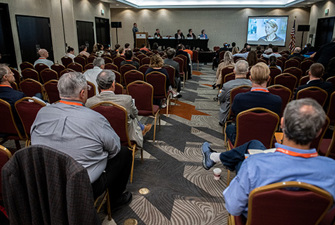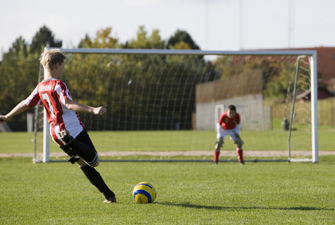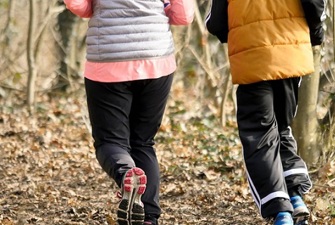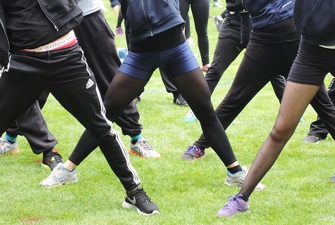Good and bad effects of corona pandemic on sports participation in Denmark
Research from the Danish Institute for Sports Studies shows that the corona pandemic has affected participation rates in sport and exercise both negatively and positively. Whilst 20% have stopped exercising, 25% of those who were not active before the pandemic, now exercise regularly.
On 11 March 2020, the Danish prime minister, Mette Frederiksen, closed down many sectors of Danish society including sports activities and facilities in both the public and the private sector. Outdoor training facilities were reopened late May and indoor facilities – including fitness centres – were reopened in early June.
Starting in April, the Danish Institute for Sports Studies has carried out three representative web surveys in Denmark to follow the impact of the corona pandemic on participation rates in sport and exercise – in April as a stand-alone survey, and in June as a survey that was repeated with the same panel in September.
During lockdown: Pronounced fall in participation rates
In the April survey, 55% of all participants said they had engaged in sport and exercise activities regularly before the lockdown. During the lockdown period this overall participation rate fell to 39%. Moreover, 38% of those who were normally active in sport and exercise had stopped (figure 1).
Figure 1: The share of people who were active before but stopped or continued participating in sport and exercise during lockdown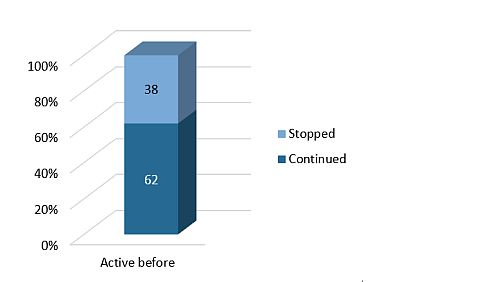 The survey showed that people who normally did sport and exercise in an organised context such as a sports club, an evening school, or a fitness centre were more likely to stop than those who normally organised their own activities or combined self-organised and organised activities (figure 2).
The survey showed that people who normally did sport and exercise in an organised context such as a sports club, an evening school, or a fitness centre were more likely to stop than those who normally organised their own activities or combined self-organised and organised activities (figure 2).
Figure 2: The share of people who continued or stopped their activities depending on the way their normal activities were organised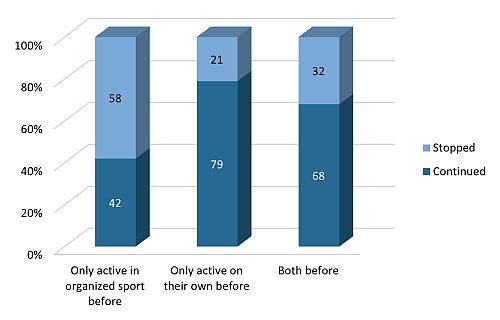 Whilst a significant proportion of Danes stopped their normal sport and exercise activities during the lockdown, 10% of those who had not been active before the lockdown, took up sport and exercise during this period. Most of them were women in their 20’s and 50’s who either worked from home or had been laid off as a consequence of the lockdown and therefore may have experienced more flexibility in their daily schedules.
Whilst a significant proportion of Danes stopped their normal sport and exercise activities during the lockdown, 10% of those who had not been active before the lockdown, took up sport and exercise during this period. Most of them were women in their 20’s and 50’s who either worked from home or had been laid off as a consequence of the lockdown and therefore may have experienced more flexibility in their daily schedules.
Interestingly, the survey showed that many people did not substitute a closed-down activity with a new activity even though many facilities were closed. The only activity that was more popular than usual during the lockdown was walking. The number of runners and cyclists remained the same even though these activities are not reliant on access to specific facilities (figure 3).
Figure 3: Percentage of people who engaged in specific activities before and during lockdown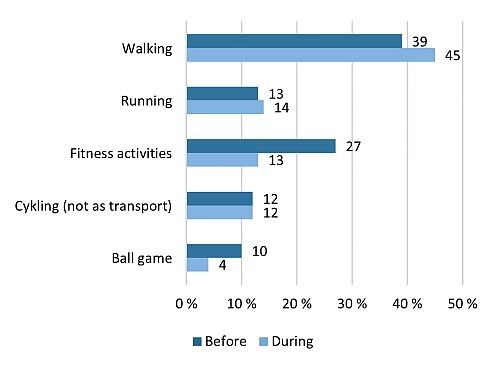
The survey also showed that many of those who were active during the lockdown used apps, online streaming and other digital offerings to a much larger degree than usual. This applied in particular to young people.
After reopening: A slow return but steady rise of newly active
After the reopening of outdoor and indoor sport facilities and activities, the Danish Institute for Sports Studies researched the effects of the reopening by recruiting a new representative panel of participants that were surveyed in both June and September about their activities before lockdown and now.
In this survey, 65% reported that they had been active in sport and exercise before the lockdown in March. In June, the overall participation rate was 54% and in September the number was 61%.
However, not all who stopped during the lockdown have returned to their activities. In fact, 20% of those who used to be active in sport and exercise in March have yet to come back. Rather, the rise in the overall participation rate is due to the fact that 25% of those who were not active before the lockdown now report to have taken up sport and exercise by September (figure 4).
Figure 4: The share of people who were active or not active in June and September related to whether they were active or not active before the lockdown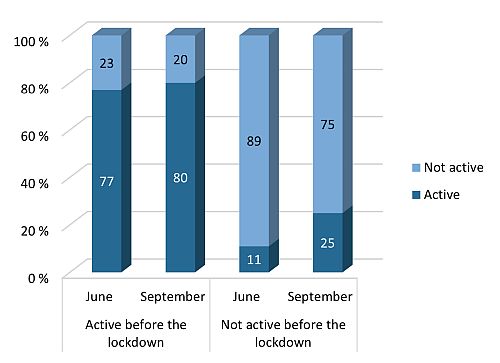
The newly active are mainly adults in their 20’s and 30’s who have taken up self-organised activities such as walking and hiking, fitness, and running. Their main reasons for becoming active are a wish to improve their health (48%), get more energy (29%), and that activities are a good way to get out of the house (23%).
Those who had not returned to their sport and exercise activities by September come from all age groups but the majority are in the group of 70 years+. Close to a quarter (23%) of those who have stopped say that they do not have the energy to resume their activities.
Half of those who were not active by September were not active in June either, and their reasons are that their normal activities are still closed down (29%), that they are taking a break (26%) or are worried about contracting the corona virus (20%). The other half were active in June but have stopped since due to illness or injuries (21%), because they spend time on different things now (19%), or have less spare time (17%).
The participation rates in most organised sports activities are on the way up, particularly for ball games and gymnastics/dance, although participation in fitness activities is still at a significantly lower level than before the lockdown. However, the majority of Danes (58%) are still doing sport and exercise on their own.

